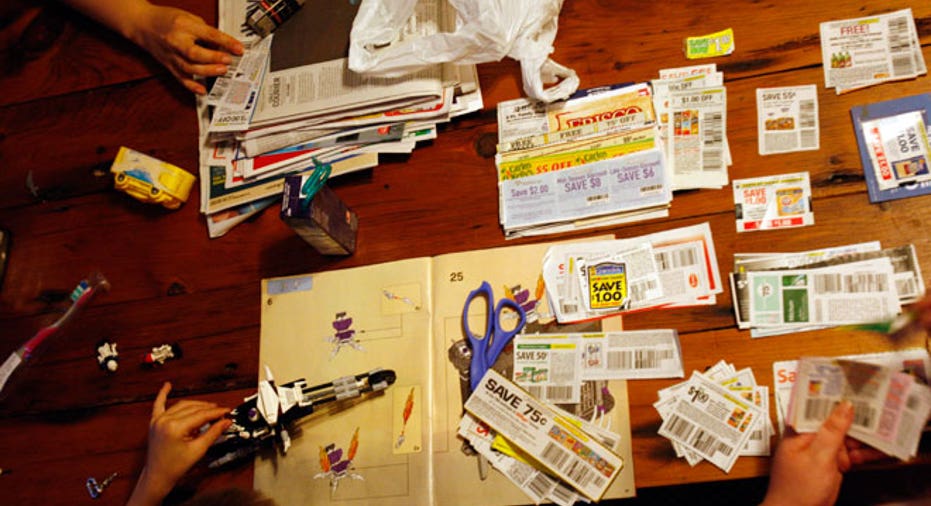Couponing Can Save You $30 a Week!

How much time would you spend to save some money? A new survey found 62% of shoppers spend up to TWO HOURS a week searching, scanning and scouting for discounts. Does it pay off? Shoppers say it sure does, and report they saved up to $30 each week using coupons.
Another interesting sign of the times: The annual Valassis/RedPlum Purse String Study reveals there was an 18% increase this year versus last year in those spending less than one hour looking for coupons, but the average savings remained consistent. “These findings indicate that consumers are still very interested in savings and have developed a forever frugal mindset,” said Lisa Reynolds, Valassis Vice President of Consumer Engagement. “They have become so accustomed to searching for value that these deal-seeking behaviors have become second nature to them. They clearly value the dollar as well as their time.”
Are people still clipping coupons the old fashioned way? The survey found people are actually becoming quite “social” about saving! Eighty-two percent said they share and swap coupons and deals with family and friends regularly.
Social media is also playing a big role too. When shoppers were asked what they would do to receive 25% or more in savings, 75% said they would sign up for an email newsletter; 67% would “like” a page on Facebook; and 17% would Tweet or Retweet a deal, up 5% from 2011. Social shoppers who share deals with friends and family tend to save more. According to the study, 50% of respondents who “always” share deals save $31 or more weekly; compared to 18% of people who “never” share deals.
Savvy shoppers use both traditional and digital sources to garner the most savings. The number of respondents comparing prices online and in print is up 9% over 2011. Sixty-one percent of respondents plan their shopping trips around circulars, coupons and deals, up 10% from 2011. Those using their smartphones for savings are most often accessing a coupon in an email followed by comparing deals, downloading a coupon and downloading a savings app.
The Purse String Study also reveals that:
- More consumers are using mobile coupons and apps since last year, up over 100% from 2011;
- While all income groups significantly increased their usage of mobile coupons and apps, those in the less than $20,000 income level group tripled their response over last year;
- 79% of respondents who are increasingly planning their shopping around circulars save up to $50 weekly;
- 79% of respondents using more mobile coupons this year are saving up to $50 a week;
- 82% of respondents who are using more online coupons this year are saving up to $50 a week; and
- 88% of deal seekers are most likely to visit their favorite savings or deal websites at least weekly.
Grocery store coupons! The survey found consumers are still most interested in finding coupons, codes and deals to use at the grocery store. That’s consistently remained the number one category, followed by dining out/restaurants and clothing coupons. Items that ranked lower in previous years are starting to rise from the recession, such as travel, a 29% increase over 2011 and services such as dry cleaners and hair salons – a 25% increase over 2011.
According to the RedPlum Purse String Study, 71% of respondents most often get their coupons and deals from the newspaper, followed by emails/coupon alerts, retail circulars, Internet searches and mail. Additionally, the percentage of consumers who most often use mobile phone text messages to get a deal doubled from 2011.
For the third consecutive year, a majority of shoppers (60%) said they are using the savings for basic necessities, although that is down 16% from 2011. Paying down debt, which ranked No. 2 in 2011 and 2010 was significantly lower than the past two years with only 4% allocating their savings toward debt. Long-term savings (i.e. college/retirement) ranked second in 2012, accounting for 15% of respondents. Only 3% said they would use the money saved from couponing to splurge, down from 7% in 2011. Yet, respondents’ confidence over their family's financial situation has remained fairly static over the past three years with a slight upswing in 2012.
The 2012 RedPlum Purse String Study is based on insights from more than 9,100 respondents. The survey was conducted on redplum.com from June 12 through July 11.
Read More from GalTime.com: